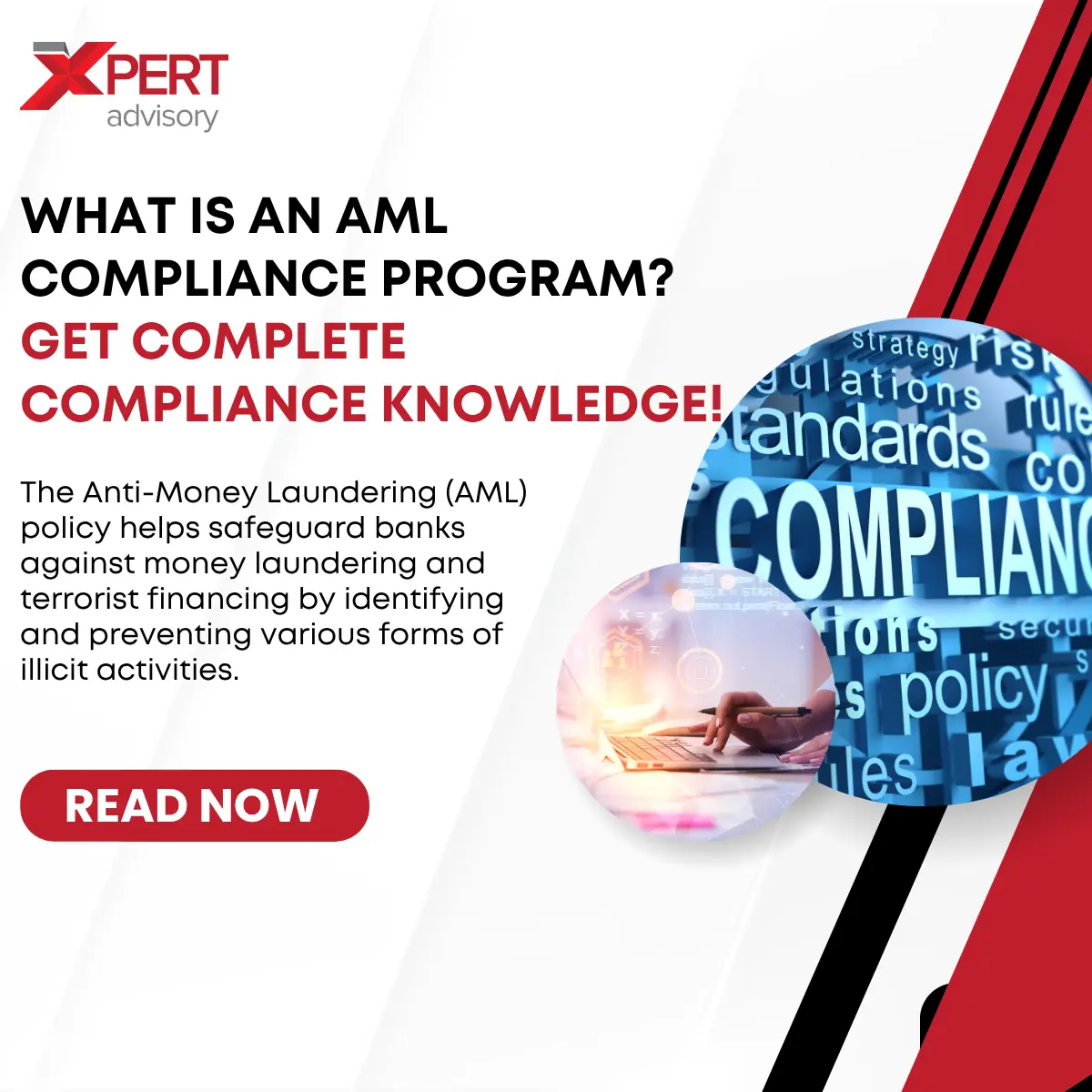Anti-Money Laundering (AML) policy functions to protect banks from money laundering and terrorist financing activities by detecting other forms of illegal practices. Every financial business needs to follow AML rules when operating within specified industries. However, risk and compliance team members face the difficult task of developing robust AML compliance programs. So, in this guide, we’ll discuss what is an AML compliance program and how this procedure helps to detect and prevent money laundering.
What Is an Anti-Money Laundering Compliance Program?

An Anti-Money Laundering (AML) compliance program is a set of policies and procedures that establish operations for organisational compliance work. Financial institutions (FIs) obtain direction from these programs concerning how to detect potential money laundering crimes together with their operational methods to combat this crime.
The need for continuous updates in rules and regulations makes sustaining AML compliance processes a permanent operational task. Renowned institutions create regulatory compliance programs by adapting them to match business demands and the particulars of their services, along with their clients’ profiles. It cannot be one-size-fits-all.
What Makes an Effective AML Compliance Program?
The Federal Financial Institutions Examination Council (FFIEC) establishes critical features that make an effective Bank Secrecy Act compliance program mandatory for institutions.
- A compliance program must have an internal control system to maintain a continuum of compliance operations.
- Financial institutions should execute disorderly verification tests through their staff members or independent regulators to ensure compliance.
- The organisation needs to assign one person to serve as the AML compliance officer who must oversee compliance work on a daily basis.
- Ensure ongoing AML training program for employees.
- The program should develop a risk-oriented verification system to authenticate customer identities called the Customer Identification Program (CIP).
Professional services should incorporate Customer Due Diligence (CDD) practices and follow all beneficial ownership standards issued by FinCEN through their regulatory directives.
What Is the Purpose of an AML Compliance Program?
The practical implementation of an AML regulations needs institutions to maintain the ability to identify suspicious transactions for financial fraud, money laundering, tax evasion, terrorist financing, and several other financial crimes before reporting them to authorised law enforcement agencies. A financial institution can reach its AML objectives through three essential steps.
- Credible Reporting: Having an established trustworthy reporting structure enables instant notification to relevant enforcement authorities when money laundering transpires.
- Looking for High-Risk Customers: AML effective compliance programs require businesses to concentrate on both their technical systems for money laundering detection and also the vulnerability posed by their most dangerous clients. Financial institutions need to conduct customer assessments combined with customer due diligence and enhanced due diligence methods for appropriate profiling to detect risky profiles and take immediate corrective actions.
- Hire Compliance Officer: The entire operation relies on a compliance officer to execute this procedure efficiently and effectively. To result in a successful program, organisations must begin building from a deep understanding of regulations and appoint competent staff who understand how to establish compliance throughout the workforce.
All team members from different organisational levels have an ethical duty to practice compliance management effectively. Individuals in a company need to recognise suspicious activities while having clear channels for reporting such occurrences.
Key Components For Effective AML Program
Now that you know what is an AML compliance program, let’s move on to its components. An efficient AML compliance system depends on these six essential best practices:
- Designation of an AML Compliance Officer
To establish AML procedures, the organisation must appoint a BSA compliance officer to handle them. A well-qualified expert officer who comes with experience needs to be selected as the main person in charge of running AML screening and operations because these operations are highly sensitive.
This designated person functions as the central point for money laundering and financial crime matters throughout the institution to bridge communication between different departments. AML professionals form a vital element that defends organisations against failure to comply with regulations and breaches and helps prevent administrative penalties.
Money Laundering Reporting Officers function as these professionals’ official titles in multiple jurisdictions. All jurisdictions assign varying names to compliance officers who bear important responsibilities that consist of the following:
- The staff needs to receive and assess all suspicious transaction/activity reports that come in as (STR/SAR).
- Taking necessary decisions regarding STRs/SARs
- Leading the AML/CFT compliance function
- Overseeing risk management strategies
- Effective reporting of relevant matters takes place between senior management teams and regulatory organisations.
- The firm uses this professional as its regulatory connection to maintain continuous communication with relevant authorities.
- The organisation must maintain a general attitude of compliance throughout its structure.
- Regulatory knowledge must be sufficient for the team, along with maintaining awareness about industry alterations.
- The execution of all duties needs to occur ethically, with integrity, and without bias.
- The officer must maintain clear dialogue channels between compliance and senior management departments.
- Risk Assessment
An AML compliance program starts with performing a detailed risk assessment, which is its foundational element. All organisations need to assess and verify every possible money laundering or terrorist financing risk that involves customers and their products and services, along with geo-locations. Organisations understand their risks better, and they create customised strategies to handle these specific problems.
- Internal Policies and Procedures
Creating written documentation for anti-money laundering compliance programs requires focus at this particular point. A financial institution must deliver its AML compliance commitment through rules that define employee duties and methods to identify suspicious conduct and make reports.
The essential process of regular review and update ensures the approval of new regulatory requirements since risks emerging from evolving environments demand such changes.
- Conduct Ongoing Monitoring
A crucial step involves putting in place a customer monitoring system that tracks clients perpetually. The system develops autonomous tools that trigger warning systems to detect any probable anomalies or money laundering activities. An ongoing control process must combine exceptional alertness with a flexible approach and sustained commitment in order to detect and halt sophisticated financial schemes of fraud.
- Customer Due Diligence
Organisations must create solid Customer Due Diligence procedures to sustain anti-money laundering compliance requirements. Risk-based checks of customer profiles combined with monitoring of transactions that appear deviant or questionable make up the protocol. PEPs, along with citizens from low-supervision countries, qualify as high-risk individuals who need priority attention in an upgraded AML/CFT program.
- Independent Audit And Review
Regular AML compliance audits, together with continued monitoring, help organisations discover the areas where improvement is needed. External auditors can perform a transparent assessment of program outcomes to identify points for enhancing the AML/CFT program.
The auditing process highlights organisational process weaknesses, which enables management to develop compliance measures that strengthen their AML programs.
- AML Training And Awareness

The essential component of AML awareness consists of teaching staff about rules and prevention systems and threats that appear in new formats. Staff members need ongoing training sessions to receive the most recent threat updates as well as status changes in regulatory requirements.
Moreover, the combination of awareness-based systems to report questionable actions creates essential conditions for employees to function as active defenders against financial fraud and money laundering.
A strong AML compliance program consists of these core components, which enable businesses to satisfy regulatory requirements and join the global fight against financial illegalities.
Tips for the Implementation of Robust AML Compliance Program
As you have learnt about what is an AML compliance program and its working, you must implement specific best practices to develop and keep the most effective AML compliance program operational. These include:
- KYC and KYB
During onboarding, Know Your Customer (KYC) demands that organisations obtain customer information that helps validate identities and assess risks affecting the business. Knowledge-based evaluation of business entities, known as KYB, helps financial service providers establish key information about their suppliers and business customers.
The procedures detect financial crime by allowing the identification of dangerous persons. A successful AML compliance program starts with the completion of KYC and KYB processes.
- Enhanced Due Diligence (EDD)
Enhanced Due Diligence remains essential to the Know Your Customer/Know Your Business approach because companies need this method to protect themselves from high-risk profiles. An extensive examination is performed to fill in all areas not examined through KYC/CDD processes.
The implementation of Enhanced Due Diligence must occur whenever companies need it to conduct incidents, such as dealing with PEPs or businesses established in enumerated high-risk third countries. Businesses within high-risk operational sectors, which span from gambling to banking, need to create standard EDD procedures.
- Keep Track of AML Regulations
The authorities create systematic reports about AML and CFT while modifying their rules based on economic and technological advancements. The authorities do more than follow the implementation process by sharing routine suggestions.
The AML officer, together with the software provider, needs to perform these checks, especially for the business areas where they work. The execution of an updated compliance policy stands as the only meaningful activity for businesses.
- Independent Third-Party Audits

Regular third-party audits enable companies to thoroughly review their extensive records and actions and vast customer database, even though many organisations miss small details among the large data volume.
Maintaining knowledge of domestic and international regulatory updates presents organisations with substantial difficulties. Moreover, external professional audits on a regular basis serve as a beneficial solution to prevent regulatory noncompliance and missed details.
Summary
Understanding what is AML compliance program allows businesses to initiate effective financial crime prevention against money laundering and fraud schemes. Your organisation must build an effective structure that includes choosing a compliance officer to do risk assessments and conducting continuous training and periodic audits to stay compliant. An AML compliance program demands constant refinement because laws and risks evolve regularly, which makes maintaining compliance a continuous responsibility.
Does your company require assistance to establish or enhance its AML program structures? Xpert Advisory is here to assist. Our AML compliance consultants develop implementable solutions that adapt to your business operations, the degree of risk, and specific regulatory requirements. Contact us now to be your reliable partner for AML compliance!
FAQs
What Makes the AML Compliance Program Important?
Institutions implement an AML compliance program to shield against illegal money laundering and terrorism financing activities and commit fraud. A properly implemented AML compliance program makes businesses comply with government regulations, which prevents penalties and protects their brand image and legal position.
What are the Methods Used in AML Transaction Monitoring Systems?
Real-time and retrospective analysis of customer transactions during transaction monitoring allows institutions to detect abnormal or questionable activities suggesting money laundering or fraud.
Who has the Authority to Maintain AML Compliance Within a Company Structure?
The program gets oversight from a special individual designated as a Compliance Officer or AML Officer. Their roles include both implementing controls and performance checking report filing and keeping track of evolving laws.


